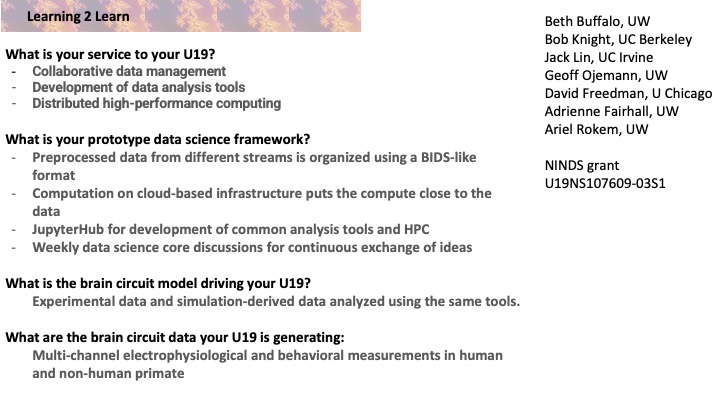Back to U19 Main Page
- U19 – brief description overall project goals, competing circuit theories being developed/studied/integrated: Our U19 collaboration studies rapid learning in primates (both human and non-human). We are interested in the ways in which flexible behavior arises from the apparent ability of primates to very rapidly learn complex tasks and rules, and to adjust these rules, as the environment changes.. This topic is particularly interesting and important, because the ability to learn how to learn seems to be a hallmark of human behavioral flexibility and high-level cognitive abilities. Moreover, while artificially-intelligent systems have evolved to perform many kinds of learning tasks at near-human performance levels, this kind of flexibility still largely eludes these systems altogether.

- Description of how Data Science Core is complying to the criteria of the FAIR principles:
- Developing a data catalog
- Release of datasets through CRCNS.org with publications
- Use of interoperable file formats: BIDS and NWB/HDF5
- Release of analysis software with publications
- List of Data Types in U19: Multi-channel electrophysiological recordings of brain activity are obtained in awake behaving humans and non-human primates, while they perform complex behavioral tasks. In non-human primates, recordings are conducted using novel multi-channel drives that provide dense chronic high-quality recordings from multiple regions, including areas of the prefrontal cortex and the hippocampus. In human epilepsy patients, intracranial electrocorticography (ECoG) recordings are conducted in multiple areas on the cortical surface and stereoelectrocorticography (SEEG) recordings are conducted in the temporal and frontal cortices, as well as the hippocampus and amygdala. The recordings from deep structures capture both the local field potential and activity of single neurons.. The behavioral tasks used include the classic Wisconsin Card-Sorting Task (WCST), as well as a novel task of stimulus association. One of the remarkable strengths of these data is that very similar tasks were performed in both the human and non-human primate experiments.
- Common Data Elements in U19:
- Data Sharing goals in U19: We are interested in answering a host of questions about the representations of task information in brain circuits. For example, an open question is how rule representations emerge as a function of task performance, how rapid rule switching is implemented,, and how these flexible representations relate to coding of task information in distributed circuits. It would be potentially interesting to implement artificially-intelligent systems that can learn how to learn in ways that accurately emulate the behaviors exhibited in these tasks by biological systems.
- Data science tools being used in project:
- NWB
- Jupyter
- Dask
- Kubernetes
- Data science tools being developed for project:
- Pan-neuro
- Data science approaches to be shared with other U19’s:
- Pan-neuro
- Data science challenges that could benefit from discussion with other U19’s:
- Data sharing
- Scalable computing
- 2021 BRAIN PI Meeting Update, https://docs.google.com/presentation/d/1QzmS37cmnvOqC5DYA07jNdFORF7azRs…
Link to Data/Model Reuse abstract, [Link]
2021 Brain PI Meeting
Update:
Link to Poster:
Demo:
Back to U19 Main Page
Table sorting checkbox
Off

